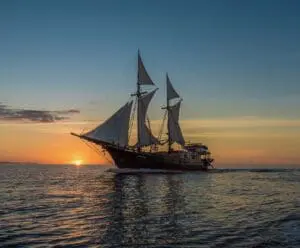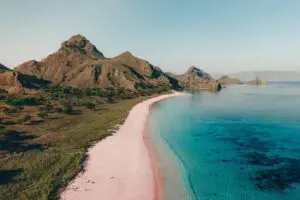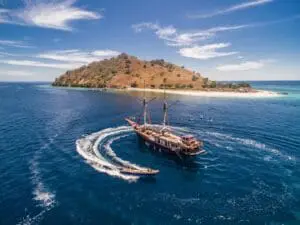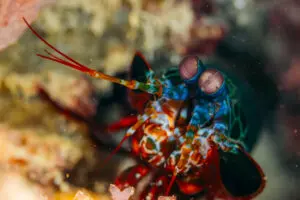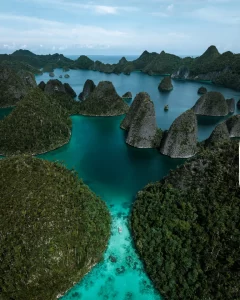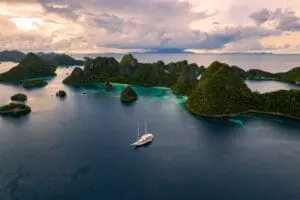In the northeast of Indonesia, between Celebes (Sulawesi) and New Guinea, lies a collection of islands steeped in history and natural beauty.
One known as the Spice Islands, the region is known today as Maluku (or the Moluccas). These islands were once the epicenter of the global spice trade where exotic spices such as nutmeg, cloves, mace, and pepper thrived, drawing merchants and explorers from across the world.
Where are the Spice Islands?
The Spice Islands are located in eastern Indonesia, situated between the larger islands of Sulawesi to the west and New Guinea to the east. They lie in a scattered archipelago within the larger area of the Maluku Sea, encompassing both northern and southern hemispheres of the Indonesian maritime region.
These islands are part of the broader Southeast Asian island chain and are surrounded by several significant seas:
- The Banda Sea to the south
- The Halmahera Sea to the north
- The Ceram Sea to the west
This archipelago is composed of hundreds of small islands, with key clusters playing critical roles in the region’s history and trade. Today it is known as the Moluccas.

Why were the Spice Islands important?
A Historic Trade Hub, the Spice Islands were integral to the thriving trade networks of the Far East long before European explorers ventured into the Indian Ocean in 1498.
Spices from the islands were exchanged for Chinese silks, Indian cottons, Arabian coffee, and African ivory, enriching civilizations across Asia and beyond.
However, it was the exorbitant spice prices in Europe that truly underscored the islands’ importance. Spices made their way to Europe through a complex overland route, passing through multiple traders, each adding a profit margin.
By the time the spices reached Venice, the primary trade hub between Europe and the East, their prices had soared to 1000% of their original value. This lucrative trade inspired a fervent search for direct sea routes to the islands.
Why were they called the Spice Islands?
The Spice Islands, now known as the Maluku Islands in Indonesia, earned their name due to their role as the world’s primary source of valuable spices like cloves, nutmeg, and mace during the height of the global spice trade.
These aromatic treasures, highly sought after in Europe and beyond, were native to these islands and could not be found elsewhere. The unique climate and volcanic soil of the region created ideal conditions for these spices to thrive, making the islands a focal point of exploration, trade, and conflict among European powers in the 15th and 16th centuries.
European Exploration and the Spice Trade
The Portuguese were the first Europeans to establish direct trade with the Spice Islands, arriving in the 1520s. They were followed by the Dutch and English approximately 80 years later.
Despite the challenges of navigating uncharted waters, the profits from the spice trade were enormous. For instance, the first English spice voyage in 1598 resulted in significant profits, even though two of the three ships were lost and only a modest cargo of spices was acquired.
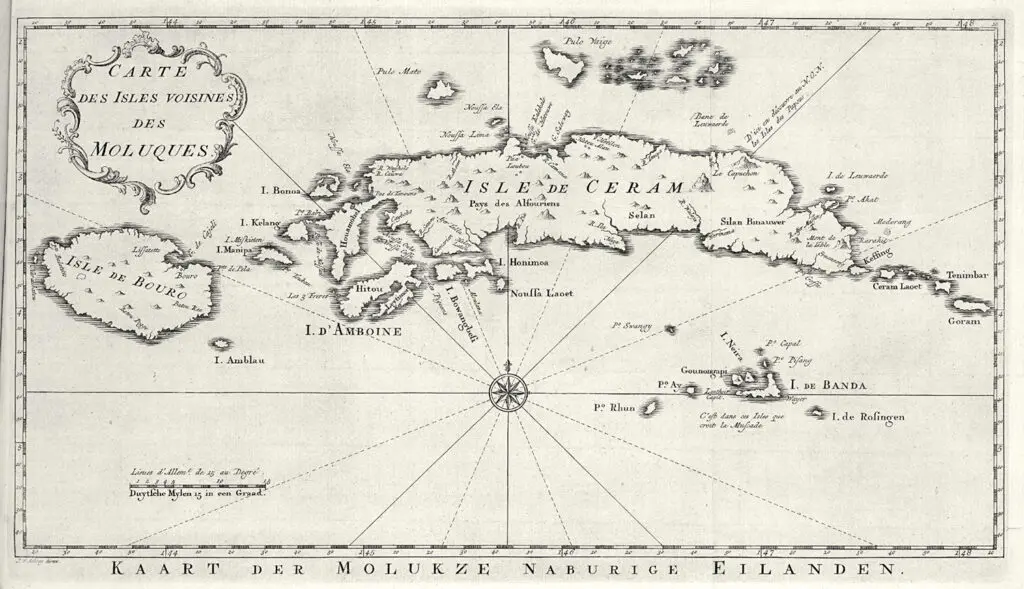
Main Islands of the Spice Islands
The Spice Islands or Maluku Islands are divided into two provinces: Maluku and North Maluku. They encompass approximately 1,000 islands, known for their lush landscapes, active volcanoes, and palm-lined beaches. Among the most notable islands are:
Banda Islands
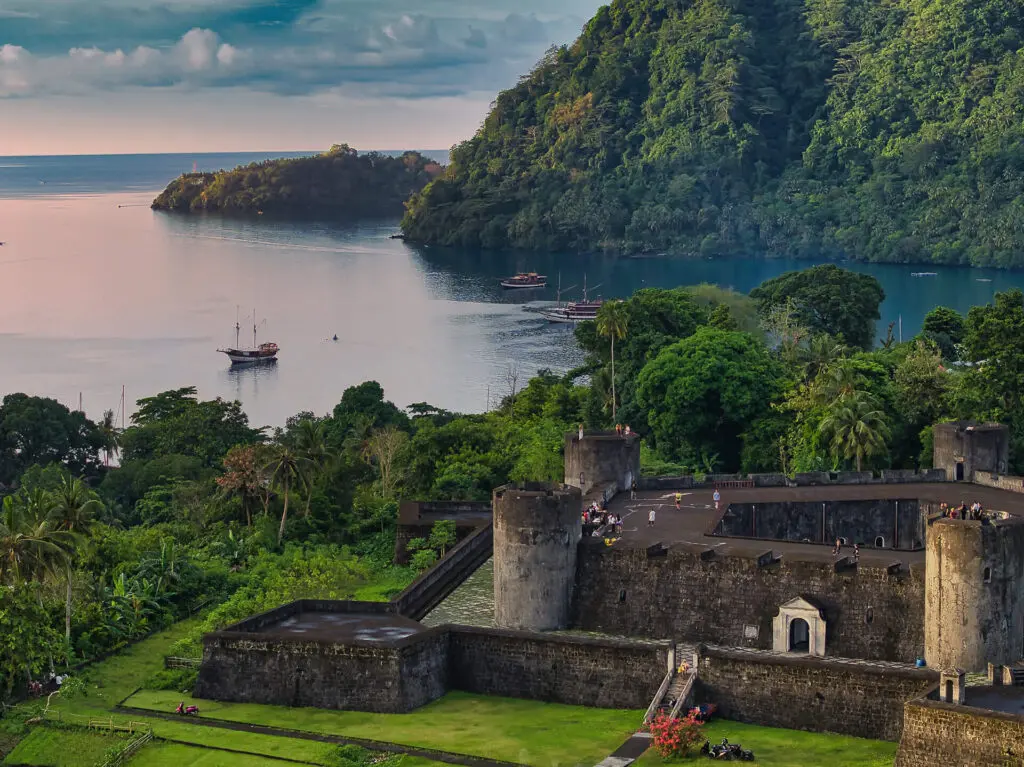
The Banda Islands, a cluster of 10 small volcanic islands, were the world’s sole source of nutmeg and mace during the height of the spice trade.
Located in the Banda Sea, they were highly coveted by European powers such as the Portuguese, Dutch, and English. The most prominent islands include Banda Neira, the administrative center; Banda Besar, the largest island; and Pulau Run, which became infamous for being traded by the British to the Dutch in exchange for Manhattan.
With rich colonial history, the islands are home to forts, old plantations, and cultural remnants from centuries of spice cultivation. Today, the Banda Islands are a paradise for divers, offering pristine reefs and abundant marine life.
Key Islands of Banda:
- Banda Neira (the main island)
- Banda Besar
- Pulau Run
- Pulau Ai
- Pulau Hatta
- Pulau Pisang
- Pulau Keraka
Ternate

Ternate, one of the most famous Spice Islands, is dominated by Mount Gamalama, an active volcano that looms over its landscape.
Historically, it was the seat of the Sultanate of Ternate, a powerful trading kingdom that controlled clove production and commerce. The island’s strategic location made it a focal point for colonial powers, leading to periods of conflict and cultural exchange.
Ternate’s old forts, mosques, and sultan’s palace are testaments to its rich past. The island is also known for its natural beauty, with black sand beaches, lush forests, and volcanic hot springs.
Tidore
Tidore, a neighbor of Ternate, was a significant clove producer and rival to the Ternate Sultanate.
With its roots in the ancient spice trade, the island played a key role in regional politics and commerce. Mount Kie Matubu, Tidore’s towering volcanic peak, adds to its dramatic landscape.
The island is quieter and less developed than Ternate but retains its charm with historical sites like forts, traditional villages, and remnants of Spanish influence. Tidore’s strategic importance during the colonial era is reflected in its role as a key battleground for European powers.
Ambon
Ambon Island, the capital of the Maluku province, has a storied history as a trade hub during the Dutch East Indies era.
Although not a primary spice producer, its central location made it a key port for the transport and export of spices.
Ambon is home to Fort Victoria, a colonial stronghold, and museums that document the island’s past. Modern Ambon is a bustling city with a mix of cultures and religions, offering vibrant markets, traditional dances, and cuisine that reflects its multicultural heritage.
Surrounded by coral reefs, the island is also a destination for diving and snorkeling
Halmahera
Halmahera is the largest island in the Maluku group, but its rugged terrain and dense forests meant it played a lesser role in the spice trade compared to smaller islands like Ternate and Tidore. However, it served as an important agricultural and trading region.
The island is a hotspot for biodiversity, with unique flora and fauna, making it a haven for eco-tourists. Culturally diverse, Halmahera is home to various indigenous communities, each with its language, traditions, and customs. Its volcanic landscapes, pristine beaches, and vibrant underwater ecosystems attract adventurers and nature lovers.
Saparua
Saparua is a small but historically significant island known for its role in resistance against Dutch colonial rule.
It was one of the key spice-producing islands, with nutmeg and cloves grown in its fertile soil. Saparua is less visited than Ambon or the Banda Islands, giving it a quiet, off-the-beaten-path charm.
Historical sites like Fort Duurstede offer a glimpse into its colonial past, while its welcoming villages provide insight into traditional Maluku culture. The island’s coral reefs and tranquil waters also make it a haven for snorkeling and diving.
Seram
Seram, the largest island in central Maluku, is rich in biodiversity and culture. Known as the “Nusa Ina” (Mother Island) in local folklore, it is considered sacred by the indigenous Alifuru people. The island’s fertile lands made it suitable for spice cultivation, though it was less prominent in the trade compared to Ternate or Banda.
Seram’s rugged interior features dense rainforests, towering mountains, and endemic wildlife, making it a hotspot for eco-tourism. Manusela National Park is one of its highlights, offering opportunities for trekking and bird-watching.
Buru
Buru is an island with a complex history tied to both the spice trade and more recent events.
While it was involved in the spice trade, its remote location and rugged terrain made it less significant than other islands. Buru gained notoriety in the mid-20th century as a site for political exile.
Despite its turbulent past, the island is known today for its unspoiled natural beauty, traditional villages, and unique biodiversity. Its rainforests, rivers, and mountains offer a serene retreat for travelers seeking solitude.
Haruku
Haruku is a small island near Ambon, with a rich cultural and historical heritage. During the spice trade, it was an important location for the cultivation of nutmeg and cloves.
Haruku is home to traditional villages where local customs are still practiced, and ancient sites like sacred wells and fort ruins reflect its historical significance.
The island’s pristine beaches and coral reefs make it an attractive destination for visitors seeking relaxation and underwater exploration.
Kei Islands
The Kei Islands, though not historically as prominent in the spice trade, are part of the broader Maluku region.
These islands are renowned for their breathtaking white sand beaches, such as Pasir Panjang, and their clear turquoise waters. The Kei Islands are culturally diverse, with influences from local traditions, Islam, and Christianity.
Their relative remoteness makes them ideal for off-the-beaten-path travelers. The islands also host the Bali Kei Festival, celebrating the region’s cultural heritage and natural beauty.
Aru Islands
Located in the easternmost part of Maluku, the Aru Islands consist of hundreds of small islands.
While they were not a primary source of spices, they contributed to the region’s trade network. Known for their rich marine biodiversity, the Aru Islands are a haven for fishing and diving.
Their unique ecosystems support a variety of wildlife, including birds of paradise and saltwater crocodiles. Traditional practices and a slower pace of life characterize the islands, offering a glimpse into the region’s heritage.
Why Visit the Spice Islands Today?
Today, the Spice Islands offer a unique blend of natural and cultural experiences:
- Volcano Exploration: The islands are dotted with volcanoes, including the active Gunung Api in the Banda Islands.
- Diving and Snorkeling: Crystal-clear waters and thriving coral reefs make Ambon and the Banda Islands a diver’s paradise.
- Cultural Heritage: Colonial relics like Fort Belgica in the Banda Islands provide a window into the islands’ storied past.
- Spice Tours: Visitors can explore nutmeg and clove plantations, experiencing the aromas and flavors that once captivated the world.
Yacht Charters in the Spice Islands with Boatique Charters
Exploring the Spice Islands by yacht offers an unparalleled adventure through one of Indonesia’s most breathtaking and historically rich regions. With Boatique Charters, you can navigate these idyllic islands in style and comfort, uncovering hidden gems that are inaccessible by land. From the vibrant underwater world of the Banda Sea to the lush, spice-filled islands of Ternate and Tidore, each stop is a blend of natural beauty and cultural heritage.
Whether you’re diving pristine coral reefs, visiting ancient forts, or strolling through nutmeg plantations, a private yacht charter allows you to experience the Spice Islands at your own pace. With customized itineraries and expert guides, Boatique Charters ensures your journey is tailored to your interests, whether it’s history, diving, or simply relaxing in secluded paradise.
Indulge in luxury, adventure, and discovery as you sail through the Spice Islands with Boatique Charters, creating memories to last a lifetime.
Geographical Spread and Importance of the Spice Islands
- Northern Maluku: Dominated by volcanic islands like Ternate, Tidore, and Halmahera, this region was crucial for clove production.
- Central Maluku: Includes Ambon, Seram, Buru, Saparua, and Haruku, which were involved in clove and nutmeg cultivation and trade.
- Southern Maluku: Covers the Banda Islands (nutmeg and mace hub) and the Kei and Aru Islands, which were integrated into the broader maritime trade routes.
The islands’ strategic location near major sea routes connecting Asia, the Middle East, and Europe made them a focal point for global trade in spices, particularly during the 16th and 17th centuries. Today, the region is known for its cultural heritage, biodiversity, and remnants of colonial history.
A Legacy of Spices and Stories
The Spice Islands remain a testament to their pivotal role in global history. From their contributions to the spice trade to their breathtaking landscapes, these islands are a treasure trove of experiences waiting to be explored. For history enthusiasts, nature lovers, and adventure seekers alike, the Spice Islands offer an unforgettable journey into the heart of Indonesia’s rich heritage.

